Fifth-generation winemaker of this renowned family estate: “My first internship supervisor was Aubert de Villaine, of Domaine Romanée-Conti”
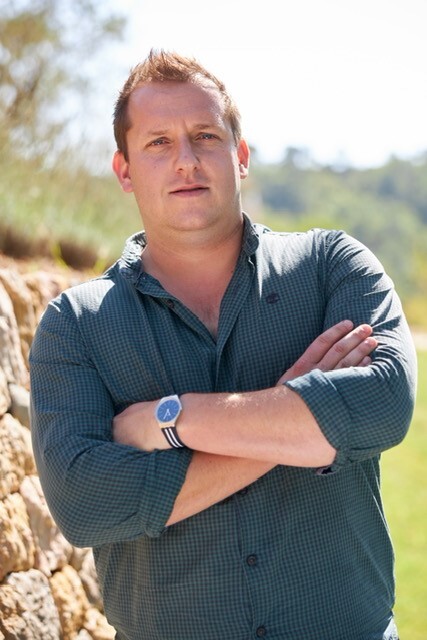
For the 16th interview in Le Figaro Vin’s series we head south down the Rhône Valley to one of its finest appellations, Châteauneuf du Pape, where we meet César Perrin, #35. Vintage after vintage he and his family devote themselves to their labours with total commitment.
An Eden in the Rhône Valley, surrounded by hills, vines, and olive trees, Château de Beaucastel is widely recognised as one of the most inspiring estates in Châteauneuf du Pape. While its origins date back to the 16th century, it was in the early 1900s that Pierre Perrin took it over. His son Jacques proved to be a true master of the winemaking craft, capable of taming the wilfulness of Grenache, while his innovative spirit led to the estate’s early adoption of biodynamic viticulture at the start of the 1970s. Today César is part of the fifth generation to carry the torch, alongside eight other members of his family, made up of his parents, uncles, brothers, and cousins. Through each successive vintage we have found ourselves utterly enchanted by the supple grace of their reds, perfectly balanced between the intensity of the fruit, the smoothness of the tannins, and an aromatic complexity which just keeps on growing deeper.
Le Figaro Vin: How does it feel to be crowned a winemaking champion?
César Perrin: I don’t think of myself as a champion. We are, more than anything, champions for our generation, continuing the achievements of our parents, grandparents, and great-grandparents before us. We have to be champions in preserving and passing on our inheritance, for we are all just passing through. It is always gratifying to know that our wines are tasted all around the world.
Have you been training for long?
Winemaking is a vocation, so we all devote a great deal of time to it, much to the detriment of our families. We train every day from a very young age. Whether in the cellar, among all the smells, or playing Le Nez du Vin and trying to recognise the fragrances, it is a little like The Drops of God. Already with my daughters, aged three and two, we taste different fruits, such as unripe cherries.
Who is your mentor?
I would say my father, who initiated us. Apart from him it would have to be my first internship supervisor, Aubert de Villaine, in 2008. He told me something that has always stuck with me: “Here at Romanée-Conti, no matter what your task is, whether it takes you an hour, or a day, or a month, you have to do it perfectly.” Ever since, I have tried to do my best on a daily basis.
Is wine a team sport?
It is for me, but most importantly wine is made to be shared and is, in that respect, a team sport. Wine is, above all, a moment for sharing, a shared emotion. You can go fast on your own, but together you go further.
What is the key to making a good wine? The terroir or the winemaker?
A great wine requires four elements: the terroir, the vine selected for planting, the climate that supports it, and the man who tends that vine. It is a combination of the four.
To what do you owe your success?
To my grandfather Jacques and my grandmother Marguerite, who turned Beaucastel into a jewel. They were pioneers, going organic in the 1950s and biodynamic in the 1970s. In rejecting the incursions of chemistry they were true visionaries.
Is your family proud of you?
I hope so. In any case, that is the great benefit of working as a family: we are very candid with each other and there is a real honesty between us. That only adds to the pressure and makes it even more imperative that we ensure our family can be proud to represent our wines.
Who is your biggest supporter?
Château de Beaucastel Châteauneuf-du-Pape Hommage à Jacques Perrin, which is our finest wine.
Your favourite colour?
Red.
Your favourite grape variety?
Mourvèdre. My grandfather was very fond of it. The grape variety was introduced to Beaucastel in the early 1930s. My grandfather went to school with Lucien Peyraud of Domaine Tempier, which is still, in my view, the greatest of the Bandols. I have noticed that the great Bandol wines were always made in the northernmost part of that appellation, while here in Châteauneuf we are at the northern boundary of our appellation. That explains why we brought Mourvèdre, which is an archetypal Bandol grape variety, to our own terroirs.
Your favourite wine?
Our whites. We have relatively very few of them, only eight to ten per cent of our production. But our Roussanne Vieilles Vignes is my favourite.
Your favourite vintage?
My first, 2012.
If your wine was a person, who would it be?
It would be a countryman.
What are the best circumstances in which to taste your wine?
With friends.
Have you ever thought about chemically enhancing yourself, or your wine?
No, quite the opposite, we have to preserve the distinctive quality of each vintage, and take what nature gives us. Nature is not always congenial, but it is what it is.
For what price would you be prepared to sell your estate?
Everything has a price, apart from family. So the question will never arise, since we want to pass it on forever.
Who is your strongest competition?
The weather.
Which competition do you dread the most?
Pruning the vines, which is such a key moment in their development.
What is your greatest trophy?
My grandmother’s pride. When she made family meals, she used to say to us: “When I am gone there is a case of wines with vintages made by me and your grandfather. I want you to open it together.” They were old magnums from 1950 and the family drank them together. It was a uniquely special experience.
What has been your most innovative strategy in the vineyard and in the cellar?
That goes back to my grandparents, with their decision to reject chemical products after the war. That has allowed us to maintain a unique ecosystem, with soils that have never been touched by chemicals.
Who would be your ideal successor on the podium?
A member of the Perrin family.
Second-generation owner and winemaker of her estate in Anjou: “The important thing is to feel alive”.
For the 13th interview in Le Figaro Vin’s series we remain in Savennières in the Loire to meet Tessa Laroche, #38. One of France’s greatest winemakers, hidden away in one of the country’s tiniest appellations, Savennières Roche aux Moines, she will celebrate 20 years at the helm of her estate in 2023.
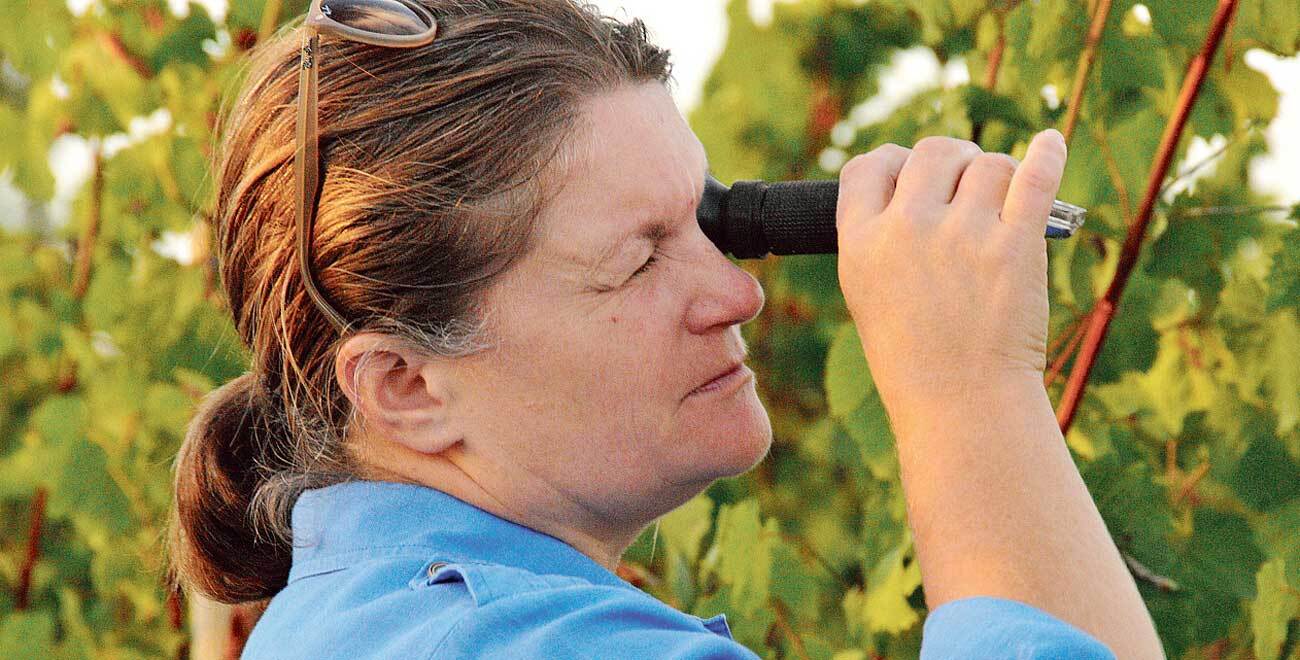
Her parents bought the property, whose wine-growing origins date back to the Middle Ages, in 1981. At that time the wine was still sold in barrels, not bottles. With each passing vintage they succeeded in converting the neighbourhood. Tessa’s mother, Monique Laroche, who passed away in 2020, was the driving force who played a major part in establishing the region’s viticultural reputation.
Her core operation remains the iconic wine of the estate, turning out between 30,000 and 40,000 bottles a year, but in recent years Tessa Laroche has branched out with a new wine, Le Berceau des Fées. This is made from young vines and matured in vats instead of barrels, while her reds, made from Cabernet Franc, display a vivacity rarely found elsewhere. Though her terroir remains her greatest love, not a day goes by without a glass of champagne. As she is fond of pointing out: “The important thing is to feel alive”.
Le Figaro Vin: How does it feel to be crowned a winemaking champion?
Tessa Laroche: I am not a champion, because it is impossible to go it alone. I am just a winemaker. I have a passion, I try to do the best that I possibly can, together with all the colleagues who work with me on the estate.
Who is your mentor?
My mother tops the list, but I would add Odilon de Varine, Charles-Emmanuel Girard, and Richard Leroy (respectively cellar master in Champagne, oenologist in the Loire Valley, and legendary winemaker in Anjou, ed.).
Is wine a team sport?
Yes, without a team you cannot function. There is always a captain, as in any sport or as there is on a ship. The prerequisites are that my team must enjoy food and wine, must have a good sense of humour, and must be happy. The wine we make is good and full of life, so we have to be in harmony!
What is the key to making a good wine? The terroir or the winemaker?
You cannot achieve the necessary level of complexity without the terroir. Without being a megalomaniac, I am lucky to have one of the finest terroirs in existence. That said, all of us are passionate about what we do and, no matter what, our love is reflected in the wine.
To what do you owe your success?
To this wonderful place, and to my parents, who came to establish themselves here. My team has been here for 15 years. Without them I would never have got this far.
The king of grape varieties?
Chenin. It is the best grape variety in the world, with its potential for total success or abject failure. You have to learn how to tame it, growing small yields and small bunches of grapes. But you can have so much fun with it, making sparkling wines, dry wines, sweet wines…you have to know how to manage it, rather like with a horse. If you give it its head it probably won’t be that good. Just now my preference is for dry wines, but the sweet wines are coming back into favour.
Your favourite wine?
Roche aux Moines 2001, my very first wine.
Your favourite vintage?
2019, which I like hugely right now, just like the 2017. But it’s constantly evolving.
If your wine was a person, who would it be?
Just like your dog, your wine takes on your appearance. My wine looks like joie de vivre because I try not to transfer my anxiety to it.
What are the best circumstances in which to taste your wine?
You should be relaxed, at the end of the morning, or after a productive day, sitting in the garden or in front of the fireplace.
Who is your strongest competition in the Loire?
For all of us here Richard Leroy is the master. We even call him God. He is always exchanging ideas, part of the conversation. He loves to share his knowledge. We have to remember that we are all just passing through and it is essential to engage with each other. There is a real solidarity in Anjou, and no one works in isolation. That is probably why the region attracts so many new establishments.
Have you ever thought about chemically enhancing yourself, or your wine?
No, that has never occurred to me. I don’t wear make-up, so why not keep my wine natural too?
Is your family proud of you?
We are siblings and everyone is delighted by the continuity of the estate.
What has been your most innovative strategy in the vineyard and in the cellar?
To get the best grapes depending on the vintage. You have to reinvent yourself every year. However, there is nothing more difficult if you are French!
Who would be your ideal successor on the podium?
God alone knows. I have six nephews and nieces. The choice has to be obvious and, above all, not put pressure on anyone. As things stand, I am in no hurry.
Owner of Domaine Belargus: “I have a bit of a PSG syndrome”.
Figaro Vin’s 39th top French winemaker, Ivan Massonnat creates sumptuous wines on Savennières’ exceptional terroir.
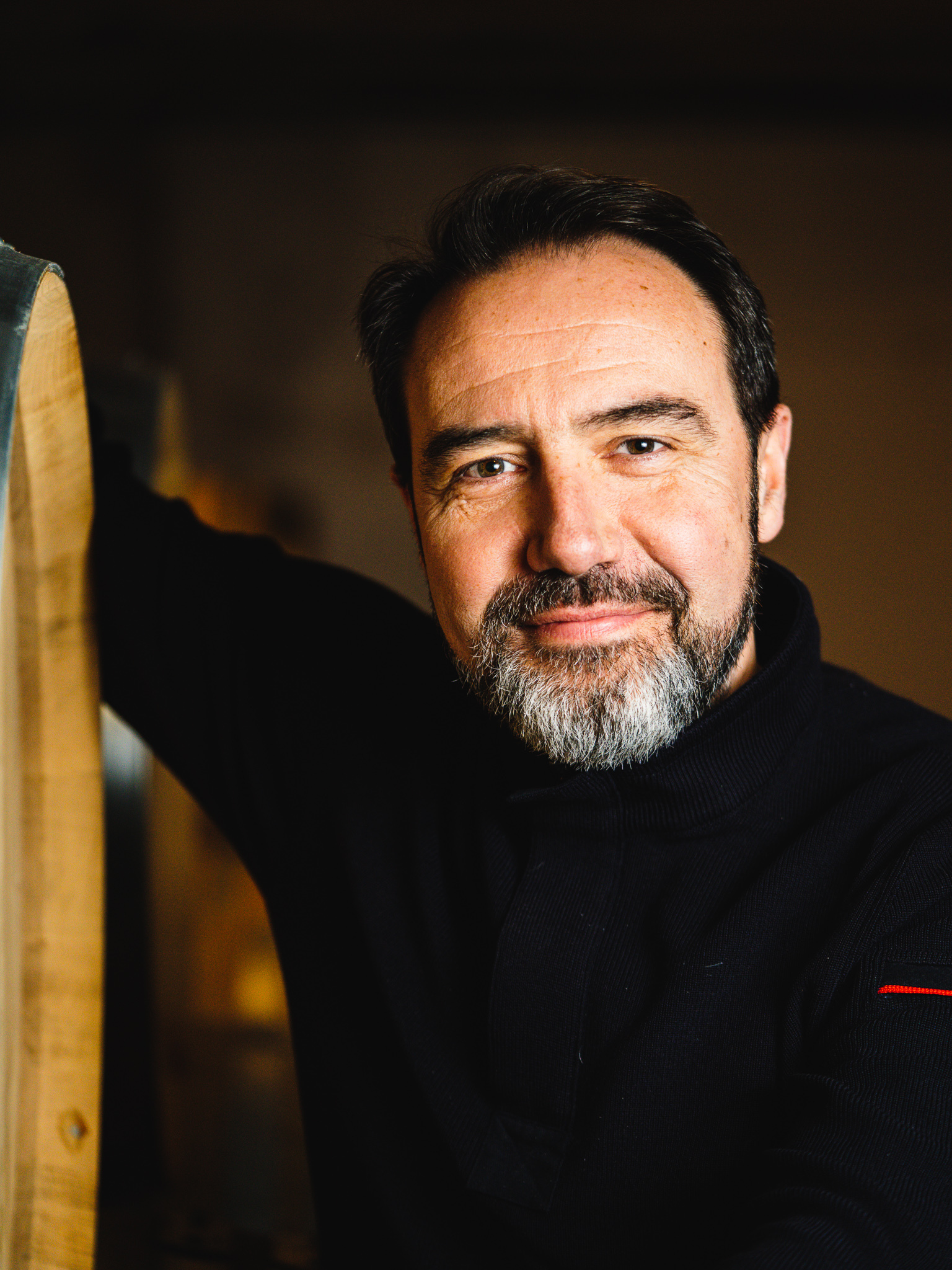
In the Loire valley, on one of Anjou noir’s finest terroirs, Ivan Massonnat is fulfilling his long-lasting dream of producing excellent Chenins from Savennières. At the Belargus estate, born in 2018 with the purchase of the Pithon-Paillé estate, 24 hectares of vines are biodynamically grown in a parcel-based approach inspired by the Burgundian “climates”. Named in tribute to the rare cuvée once made by Jo Pithon – the “Belargus des Treilles” – Belargus is also the name of a small blue butterfly that’s exceedingly rare at this latitude but can be found on the Coteau des Treilles terroir.
Le Figaro Vin. – How does it feel to be crowned a winemaking champion?
Ivan Massonnat. – I don’t consider myself to be a champion. One part of me feels like a wine amateur that’s made it and is living the dream, the other like a producer that makes his wine and takes decisions.
Have you been training for long?
Yes, since my childhood, without even realising it. My passion for vines stems from my grandfather’s vines, and I’ve trained by being in contact with real champions, of the Burgundian kind.
Who is your coach?
Jo Pithon, who’s been by my side every day throughout this adventure, with 40 vintages under his belt. I have a few other mentors, such as Thibault Liger-Belair and Philippe Pacalet in Burgundy. It’s by their side that I learnt to trust myself. There’s Pierre Amoreau from Château Le Puy, who taught me a lot. Among those who inspire me, there’s also Anselme Selosse. His approach goes far beyond that of a winemaker, he’s a true philosopher. At 45 years old, I completely changed my life, shifting towards a career I knew to be difficult. When I see a man like him, I know I’ve done the right thing.
Is wine a team sport?
Yes, definitely. I spend my time saying so. There are some people who are often cast aside, especially in the vineyard, but on my estate, it’s the opposite. You need great talent, with each individual excelling in their specialty. The members of my team are sharp and well-suited to their roles. I have the PSG syndrome; I don’t want people working in silos. If everyone isn’t aware of the whole, we cannot accomplish anything. Good ideas sometimes come from across the playing field. For me, the concept of a rugby team is the best model there is.
What is the key to making a good wine? The terroir or the winemaker?
I have a vision of making wine with a sense of place, and not all places are created equal. That being said, a good-for-nothing from the finest place will not make a great wine! I don’t believe that a winemaker is a magician.
To what or to who do you owe your success?
To all those who believed in me, my closest circle, who didn’t view my project as a pipe dream. There are also those who told my story, as well as the clients. No project can bring people together the way wine does. Each link in the chain has been important. I never imagined things would happen so fast, and the seeds would take root.
Is your family proud of you?
Yes, and very happy for me. My family has made a lot of sacrifices, but it was worth it in the end.
Your favourite colour?
I started with reds, but today I like whites just as much.
The king of grape varieties?
Chenin! It has a lot of character and concentrates a lot of different traits.
Your favourite wine?
The Coteau des Treilles, which I just call Les Treilles.
Your favourite vintage?
Probably 1989, for the reds. It’s the one I’ve had the most opportunities to enjoy.
If your wine were a person, who would they be?
Me. A profound part of a winemaker’s personality finds its way into the wine they make.
What’s the best way to enjoy it?
In good company.
Have you already thought about chemically enhancing yourself, or your wine?
No.
If you had to put a price on your estate, what would it be?
I’m not planning to. This is a 100-year project, and I don’t know what value it will have in a century’s time!
Who is your strongest competition in Anjou?
I don’t view competition that way, nor do I consider my neighbours as opponents. What impresses me is team play. My adversary could be the beer or alcohol-free drinks industries. When I see people with a waning interest in wine, I feel like we’ve missed the boat somewhere along the line.
What has been your most innovative strategy in the vineyard and in the cellar?
My most innovative idea in the region was to break the glass ceiling. What has defined Belargus is the conviction that this region produces some of France’s finest white wines and that they shouldn’t be sold at a discount. It was a risk, but in line with what I was doing. Les Treilles has been the proof of this: a 100 euro-wine from Anjou. This was completely unheard of.
Who would be your ideal successor on the podium?
I don’t know yet. I don’t want to impose this on my children. Nevertheless, one thing is certain: I will not last forever. What will remain is the terroir. My only wish is that my successor be passionate.
The best bottle for your budget
Considering the best of white Burgundy MUST BUYs across five different price points, these potential picks gain high WL scores and are all approaching or within their drinking window parameters. Wine Lister’s MUST BUY algorithm produces initial recommendations through considering a wine’s quality and value within its vintage and appellation.
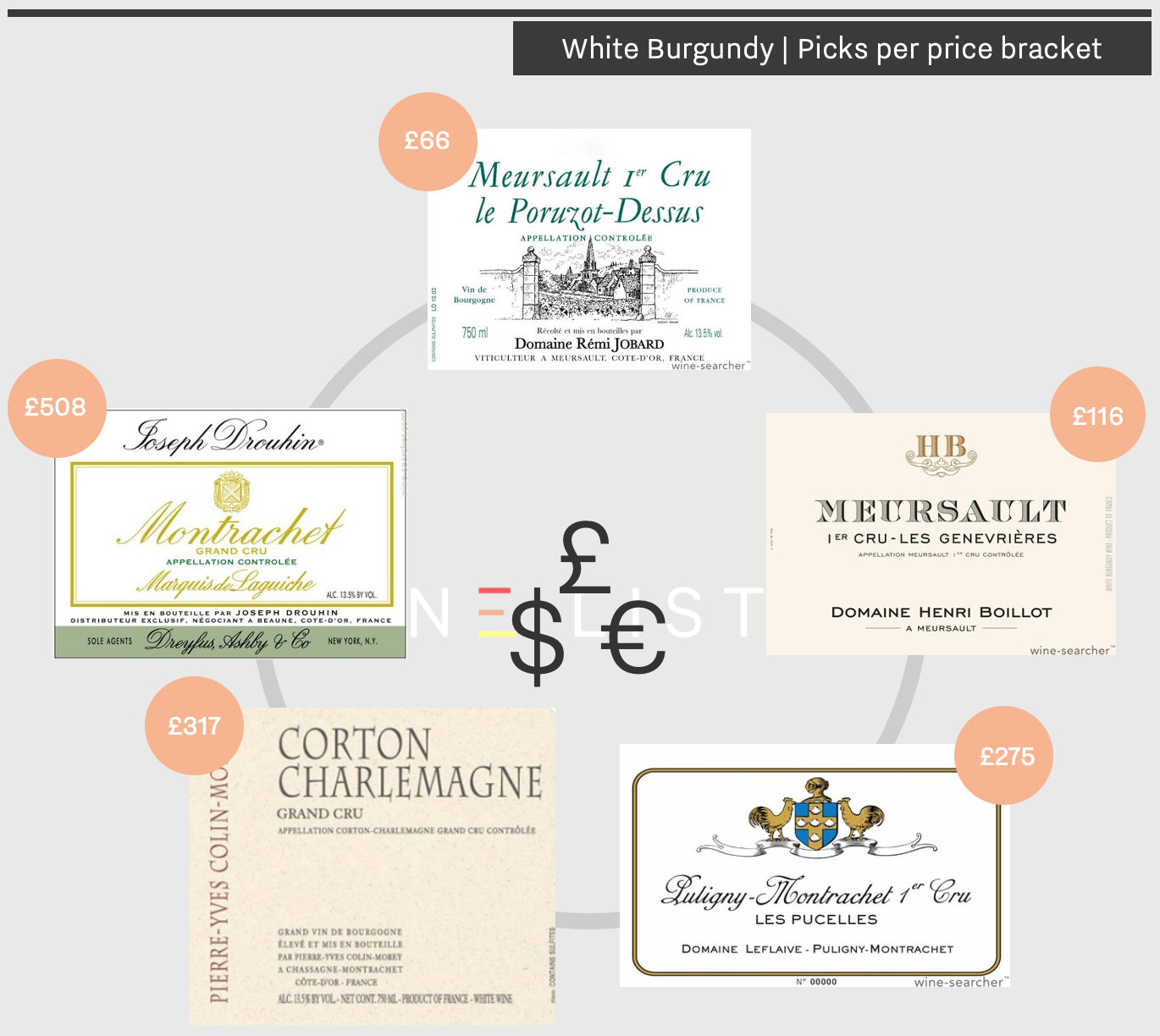 White burgundy MUST BUY picks per price bracket (per bottle, in-bond)
White burgundy MUST BUY picks per price bracket (per bottle, in-bond)
Which are the best white Burgundy wines for my budget?
Notorious for housing wines of high quality with equally high demand, Burgundy has seen some extreme price rises over the last few years. Below we explore top white Burgundies with availability across a range of prices.
With a history of winemaking in his family dating back to the 15th century, Rémi Jobard took over his namesake estate from his father in 1996, and has since overseen many developments. As well as converting to an organic practice in 2008 (and gaining certification in 2011), Rémi introduced cover crop growth across his seven vineyards to encourage the 60+ year old vines to grow deeper to find nutrients. Harbouring a naturally limited yield through cordon-pruning, Rémi Jobard produced just 2,700 bottles of Meursault Le Ponuzot-Dessus in 2015. Despite this, there is still some available of the vintage for under £100, which can be purchased from Lea & Sandeman at around £66 a bottle.
Since taking over the helm of his family property in 2005, fifth-generation wine maker, Henri Boillot has implemented several changes at Domaine Boillot. As well as a focus on sustainable farming methods, including the avoidance of chemicals, and manual harvesting, the team conducts heavy pruning to limit yields, and harvests fruit as late as possible to ensure maximum phenolic maturity. White grapes are crushed gently to avoid bitterness, and fermented in larger barrels than the typical Burgundy “pièce” (350l, vs. 228) to ensure that purity and freshness is unencumbered. Achieving a WL score of 94, the 2016 vintage can be enjoyed at its best for another 10 years, and is available to buy from Fine+Rare at £116 a bottle.
The Leflaive family legacy has been propelled into a modern era, under the founder’s great-grandson and fourth generation leader, Brice de La Morandière since 2015. As part of increased investment into refining its practice, Leflaive introduced a new type of cork in 2016, from natural cork to DIAM (made from broken down natural cork, cleaned with carbon dioxide), which increases the longevity of its bottles. MUST BUY Puligny-Montrachet Les Pucelles 2014 achieves a WL score of 94, and can be found at Corney & Barrow from £275 a bottle.
The son of Burgundy’s infamous Marc Colin (whose domain expands across 30 different appellations in the region), Pierre-Yves established his own project in 2005 from vineyards he inherited from his father. He deviates from traditional Burgundian vinification methods, utilising larger demi-muid barrels (600l) to moderate the influence of oak on the wine and preserve the purity of fruit. Gaining Buzz Brand and Investment Staple status, Pierre-Yves Colin-Morey Corton-Charlemagne 2018 has WL score of 95, and provides a solid bet for top-quality white Burgundy to lay down for the future. It can be sourced from Berry Bros. & Rudd at £317 a bottle.
Produced by négociant house Joseph Drouhin with grapes sourced from vineyards owned by the Laguiche family of the Montrachet Marquis de Laguiche estate, Joseph Drouhin’s Montrachet Marquis de Laguiche 2013 is a MUST BUY at the premium end of white Burgundy offerings. Founded in 1880 by 22-year-old Joseph Drouhin himself, the legacy of its founder’s production has been carried through generations, with the property now under the helm of his four grandchildren, Fréderique, Véronique, Philippe, and Laurent. Receiving a WL score of 96 at around £508 a bottle, the 2013 has 10 more years left of enjoyment. To get your hands on this vintage, you can place a bid for it on the Berry Bros & Rudd online marketplace, BBX.
N.B. All prices are quoted per bottle, in-bond and are correct at the time of publication (19th August 2021).
To keep up to date with our fine wine insights, be sure to subscribe to our free newsletter: https://www.wine-lister.com/subscribe/info
As well as gaining top scores across its reds, Bordeaux 2020 was successful for dry whites, notably at the highest level. Helping you to discover some of the leading examples, we explore the top five Bordeaux 2020 dry white wines by WL score.
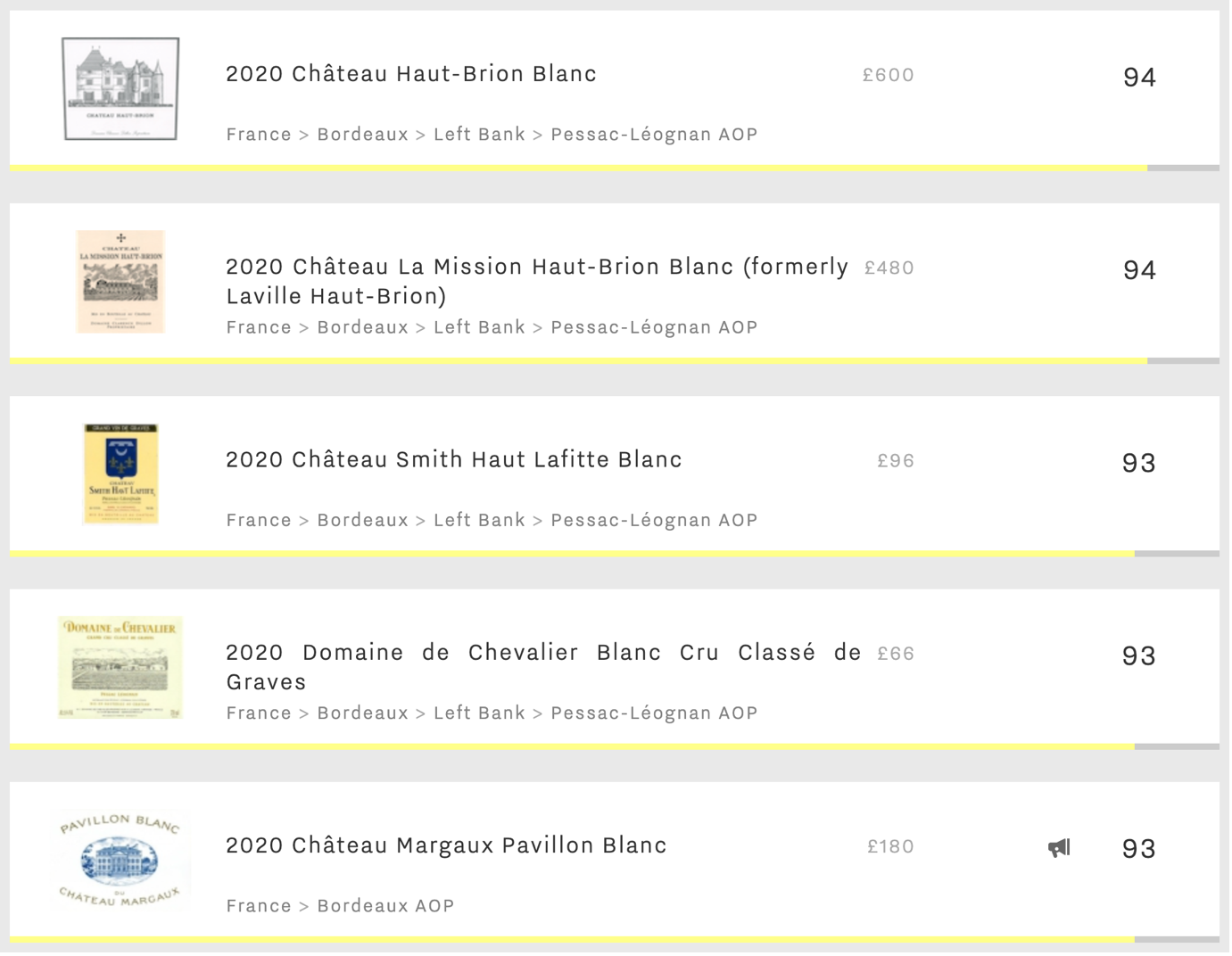 The top dry Bordeaux whites of the 2020 vintage, displayed in order of WL score
The top dry Bordeaux whites of the 2020 vintage, displayed in order of WL score
Will 2020 be a good vintage in Bordeaux for dry white wines?
Despite another exceedingly warm growing season in 2020, Bordeaux’s earlier-ripening white grapes fared well across many of the region’s top blanc producers. Having seen one of the earliest harvests on record, the first Sauvignon Blanc grapes were picked on the 14th of August, and all fruit destined for dry whites was harvested by early September. The white Bordeaux vintage therefore avoided high temperatures during the rest of the month, maintaining balance and freshness.
With a remarkably small production of just c.600 cases per annum, Haut-Brion Blanc remains one of the most sought-after Bordeaux dry whites. To combat the warm summer temperatures, the team conducted pre-dawn harvesting, picking grapes during the cooler night-time climate to ensure better levels of acidity and freshness. Wine Lister CEO, Ella Lister, found Haut-Brion Blanc to show “an almost Burgundian minerality accompanying its unmistakable Pessac green and yellow-fruit character”. With a WL score of 94, it champions the leader board of Bordeaux dry whites for the last four vintages, and there is still some of the 2020 available to purchase en primeur at IG Wines for £600 per bottle (in-bond).
Haut-Brion’s sibling estate, La Mission Haut-Brion’s white is characterised by a Sémillon-dominated blend – a grape with naturally low acidity compared to Bordeaux’s other white varietals. With soaring summer temperatures in 2020, the team therefore increased the percentage of Sauvignon Blanc in its blend to 54.7% (up from 30.1% in 2019) to ensure balance. Ella notes the impact of the increased Sauvignon on the wine’s acidity, describing a “zippy acidity, zingy energy, [with a] peach stone finish.” La Mission Haut-Brion’s white gains a WL score of 94 for the 2020 vintage, and can be found at Justerini & Brooks for £480 per bottle (in-bond).
Smith Haut Lafitte Blanc’s white vines are planted just behind the château to the north, where they benefit from a cooler microclimate that withstood high temperatures in 2020. Technical Director, Fabien Teitgen found a “nice balance and liveliness” in the grapes after harvest, while Ella characterises the 2020 as “subtle and flirtatious, building slowly into notes of white pepper and lime, as well as pure white fruit”. Gaining a WL score of 93, Smith Haut Lafitte blanc 2020 is available at Honest Grapes for £96 per bottle (in-bond).
Located at the heart of the Landes pine forest, Domaine de Chevalier’s vines are also subject to a cooler microclimate as a result of the surrounding woodland, which was certainly welcomed in 2020. When sampling the latest release at the estate, Ella enjoyed the richness of the vintage, noting “Aromas of tangerine, white flowers, custard, and acacia honey” and a palate that is “creamy and caressing […] with a lift of tension and a savoury bite.” Receiving a WL score of 93, Domaine de Chevalier Blanc 2020 can be acquired from Berry Bros & Rudd for £68 per bottle (in-bond).
Though First Growth Margaux has been producing a dry white for over 300 years, Pavillon Blanc 2020 marks the 100th anniversary under its current name. The only non-Pessac pick to feature in the top-five ranking, the success of the latest release was not without its challenges. Tasting alongside Margaux’s Managing Director, Philippe Bascaules, and Business Development Director, Alexis Leven-Mentzelopoulos, Ella was informed of the high mildew pressure as a result of a hot wet spring in 2020, which risked affecting the Sauvignon Blanc grapes of their single-varietal wine. Nevertheless, their 2020 receives a WL score of 93, with Ella describing a “Really rich, mouthcoating texture on entering the mouth – almost a Chardonnay-esque opulence”, and declaring the wine “Delicious.” Pavillon Blanc 2020 can be purchased en primeur from Goedhuis & Co for £180 per bottle (in-bond).




